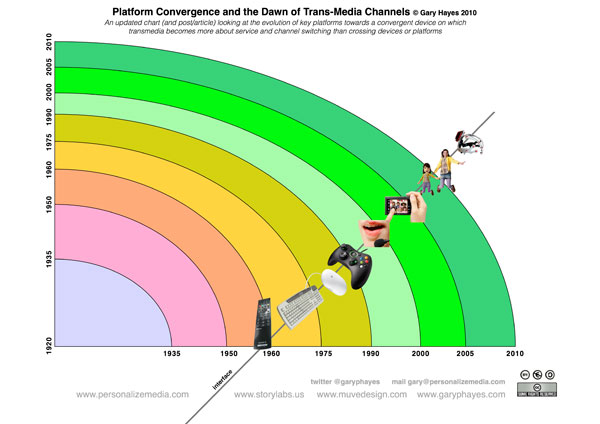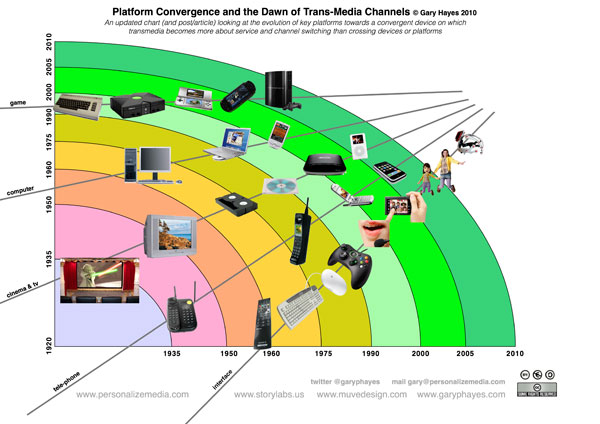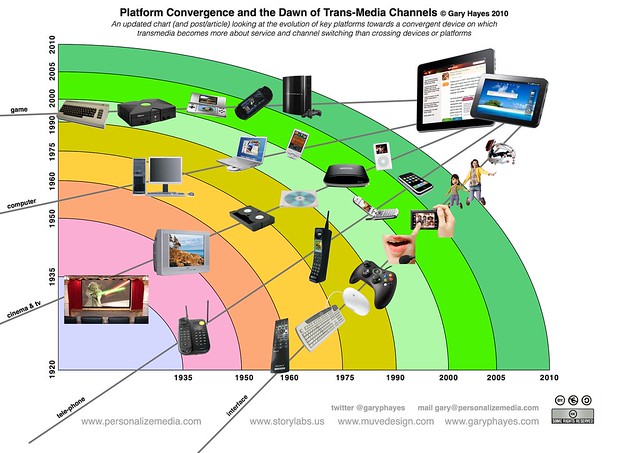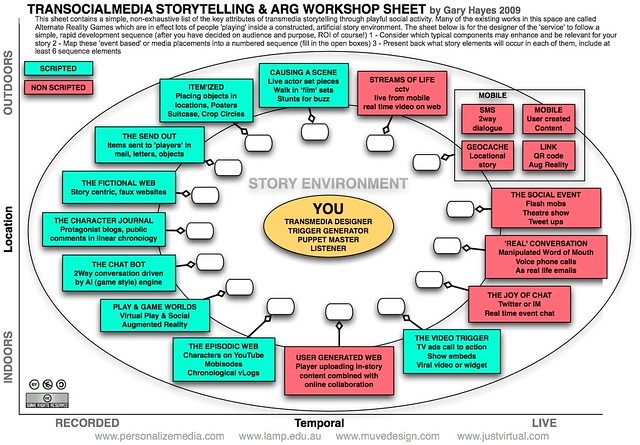Mid 2010 draft catch-up post – What will it mean when we all use a handful or even just one device to consume ‘all’ our media? Will we also use it to share ‘all’ our content, pushing it to large, dumb screens around us? When we talk about transmedia we often mean, telling a complex story across many platforms used by many users, objects and screens, perhaps partly in a book, on a TV show, inside Facebook on the PC, in a console game or at the cinema – but what will happen if all our personal media is consumed only on one screen? A world where TV is not about home screens, where Facebook is not about desk or laptop PCs and the most used games are not on chunky, dedicated consoles?
This is article is not a resurrection of the dreaded, old school (circa late 90s) convergence debate but something much more akin to the Trojan Horse saga. We are palpably moving into a space where a certain medium size screen, portable device, connected, personal & social is slowly permeating our world. As powerful and practical as all the other gadgets & screens we have gotten used to the 7-10″ tablet is has hit a sweet spot. Already the fastest selling device of all time, the iPad has caused a storm, the dam holding the waters back has leaks and other similar devices are starting to trickle out, but the dam is about to burst and we will be flooded in the next year as these tactile hybrids of smartphones and laptops seep into our daily lives – once again 🙂
Painting Original: The Marriage of the Virgin by Raphael. Public Domain
But will we converge towards this swiss army media device? Does it fulfil all our video, game, communication, work & social needs? More specifically, just as we are starting to master the ‘Art of transmedia Storytelling’ are we now looking at a mono device future? Will the art of transmedia storytelling turn into telling our stories across services and channels on a ‘single’ device rather than across multiple devices and platforms?
Context
Almost half a decade ago I did a post called Media Journeys Part 2 that explored a simple evolution of media technology from cinema at the start of the last century through to the portable revolution of the mid noughties. That post implied a device that would be a screen, with a quality good enough to view films on, portable, tactile, connected, communicative and powerful enough to play networked & graphically rich games on. This post completes that train of thought and asks a key question – are online tablets the end point of a 100 years of platform evolution and more significantly can we actually expect to see a decline in the number of ‘discrete’ platforms available to transmedia producers?
The Evolution Timeframe
Firstly the timeframe. As explained in my earlier post the most useful timeframe for this ‘postulation’ is the last 110 years – from the dawn of mass media communication and non text based story-telling (film). There has been a compression of the evolution in the last twenty years, so the curved template below reflects that year-wise. The reason the chart is curved is to allow my five key trends to converge visually.
Evolution of the Human Interface
One thing I didn’t cover in the post from five years ago was the evolution of interface which reflects how the technology has become sufficiently powerful enough for us to need to do less ‘unnatural fiddling’ at the ‘control’ end and use our bodies more naturally – less of a slave to qwerty or cross, square, circle, triangle (PS reference!)…a continuum (each number corresponds with the icon sequence, left to right, on the chart)
- The remote or keyboard – Alongside the TV in the 1950s the button based infrared remote control was born and a decade plus later early QWERTY keyboards were used (using strange alien languages) to communicate with computers. The remote is still with us today but as we know a revolution is about to take place there.
- The mouse – The PC’s popularity spread quickly when the Mac was born in the early 1980s and the computer mouse became the norm for how we interact with complex lean forward screens vs rather clunky text entry using QWERTY keyboards.
- The controller – When game consoles entered the living room in the mid 80s more complex controllers were required
- Voice – although still not universal, voice controlled PCs became usable for dictation and basic control in the late 90s
- Touch – Touchscreens were suddenly on every device from 2005 onwards and today any portable device that is not touch feels very antiquated
- Body – at the end of 2010 XBox Kinect led the way for popular use of the whole body to interact with games, of course Sony and others had launched similar interfaces many years earlier, but the 3D sensing of kinect raised the bar significantly
- Mind – (future only) having played with controllers such as Emotiv we can certainly look to a time where using parts of our body will seem so old fashioned, but that is another evolution diagram
Items 4 to 7 are of course sensory, based on natural human movement & communication.
So we need a device that responds to my touch, I can wave it around so it gets a good sense of the GPS environment it is in, as well as controlling games or measuring my physicality and without a mouse or remote in sight.
Evolution of Film and TV Viewing Screens
Before I launch into this evolution it is important to state that none of the previous platforms are replaced by the new ones – it is more likely they have a considerable impact on the numbers of people who carry on using the previous platform as their primary way to consume content. For example in January 2011 we have seen and increase of 45% in the usage of video online according to NielsenWire in this US study. So in the case of the moving image an evolution –
- Large screen projection cinema has not changed much since the early 1900s – even though crystal clear digital projection and 3D images are becoming the norm, cinema is still about the shared experience – a large screen viewed with more than four people in a large space…declining?
- In the early 50s TV began to reduce the need to visit the local cinema to get many forms of entertainment. But it still required you to tune in when the broadcasters dictated – in the very near future of course TV will be about the social and shared experience around mostly live or highly social programming…
- The introduction of VHS in the 70s to many people took viewing away from cinema owners and TV broadcasters. Viewers now had to choice to view content on their terms – when and partly where (bedroom, lounge, garage etc:)
- This was improved considerably when DVD meant the quality of the experience was much improved and cinema like experiences came into our home spaces
- At the beginning of the noughties a range of set top boxes changed the landscape even more – whether PVR devices that allowed you to personalize the TV experience to an on-demand one, or interactive broadband connected boxes again providing on-demand through to the addition of BluRay – the living room is now one large screen connected to the world and any content you want but
- The individual and even more the mobile consumer wants personal choice and from 2005 onwards we began to see the portable media player really take off. The video iPod lead the revolution so every phone & music player with a screen eventually became a video player but
There was a demand for a more immersive experience and although holding an iPod video a few inches from your face actually has the same size of screen as a cinema, it didn’t feel ‘big’ enough.
So we need a handheld device that feels like a small TV and has enough storage for a wide range of personal video content –
Evolution of Telephony
The voice phone has been with us for nearly 100 years – and now a December 2010 survey from Marketing Charts of the US shows Half of all mobile users actively consume media via their handsets.
- In the 20s and 30s the voice only device became indispensable to many parts of the developed world.
- It took half a century before it became wireless for large numbers of the population and
- it wasn’t until the early 90s that mobiles became small enough to carry comfortably.
- The big sea change to the mobile though happened in 2006 when the iPhone led the way in touch screen, one size fits all convergent ‘smartphone’ thinking – apps, casual games, telephony, texting, photography etc:.
But we need a device that is bigger than a normal phone so we can see more, be more tactile and be immersed more but something that we still take and make calls on – we are prepared to deal with a slight weight (500g and less?) and inconvenience if it fulfils our other ten key needs!
Evolution of the Powerful Personal Computer
The personal computer has not gone through many ‘macro’ changes since its introduction in the 1980s.
- We saw the desktop, brick PC slowly evolve through the 60s-80s into
- the laptop workstation which was born in the 90s and through the late 2000s actually started to outsell its desktop parents. But for many the laptop is still too big and the netbook evolved. But there was also a parallel evolution happening
- the offline PDA in the late 1990s whet the appetite for handheld portable computing – it had a lull in the mid 2000s but
We have always wanted a portable device that is as powerful (graphically & processor) as a laptop, and is as ‘connected’ as the 3G mobile phone
Game Device Evolution
Game platforms are a much simpler evolutionary case study and recently we have seen a massive increase in mobile and smartphone game use in the US and UK – the report from Information Solutions Group show a tripling of users of games on the move since 2009 – details here on Marketing Charts.
- Early platforms became popular in the 80s and 90s either running as crude CD Roms on equipped PCs or more popular proprietary devices hooked up to the TV
- It wasn’t long before the games consoles became as powerful as PCs themselves through the 90s and the PS1/2 and XBox heralded the revolution of games as high production value, mass entertainment
- Alongside the powerful consoles there was another revolution taking place and the handheld game device eventually had a massive user base of younger gamers. Those younger players from the late 90s have grown up –
- A battle now exists between casual handheld online games and powerful 3rd generation & motion/body controlled consoles that took the world by storm from 2008 onwards.
So gamers need a powerful gaming platform, connected multi-player, tactile, mobile and with a massive choice of game apps
Anything Missing?
In terms of the evolutionary tale here, are there platform and mediums AWOL from these charts?
- Goodbye printed word? A critical strand I have left off is of course the written word! It would have made the chart much longer, stretching back a few more centuries at least. Also many folk have covered the death of newspaper due to tablet over the past two years (eg: a recent one from Ross Dawson suggesting tablets will be given away free before the year end!) – But even the last hundred years of magazines, newspapers and books would have implied a form that may have had its day, replaced by the plethora of mobile readers and laptop screens?
- Goodbye broadcast radio (and TV)? Also the radio as a form for most younger media consumers becomes just streamed audio content online delivered to their mobile devices, no different to an offline podcast or audio blog.
- Goodbye physical av media? In a mobile broadband world with a great deal of content in the cloud, why do we need any disks (DVD, BluRay, Hard Drives) or tapes at all. Everything is stored digitally, partly in the cloud, viewed briefly streamed over broadband to our storage free devices – RIP Blockbusters, RIP DVD, CD, Vinyl and eventually BluRay.
- Goodbye theatre, opera, orchestras, pop concerts? Will the personalized online choices we all have on our portable, hyper connected devices mean experiential live media is both costly and inconvenient? Or will these be the best bedfellows as we enhance and augment our live experiences with our connected tablets? – interested in your views for that particular hot potato!
So Where are we Headed?
Image above linked to high rez flickr version
OK I am not pretending the whole world will be walking around with tablets only in the next few years but I am suggesting we may have a much more distilled media world from a platform perspective. I am certainly not a typical user either walking around with iPad, Galaxy Tablet & Powerful laptop. I am also not suggesting that the ‘screen’ behaviour will change. When we are sat in a social situation we will still need to have a large shared display, but as I do often now, I wirelessly connect my tablet to my 60″ plasma or feed it out to 5.1 sound system – the key is the tablet becomes the centralised control device and to a great extent a portable Personal Media centre where the ‘shared’ experience being controlled from the tablet is a mix of passive long form video but also much more complex interaction with remote users and physical users. So it is clear from my and many other’s usage patterns that these tablets are a profound shift where Augmented reality surfaces as I defined in more detail near the top of this post (shared or portable) will become both the control and multi-channel receiver – perhaps not as pervasive as this compelling and fun video recently from Corning, which suggests we are going to need a lot of intelligent displays or as the phone item implies in the middle of the video, displays that can ‘receive’ from portable devices…
The Multi Channel Tablet and what will this mean for those telling stories across multiple services?
I wanted to spend a lot more time talking about the impact of this for transmedia storytelling but realised that the shift here will be relatively straightforward. The techniques for creating your story worlds across the ‘platforms’ will simply shift to ‘services’. In my oft downloaded diagram here…
we now need to consider the impact of the variety implied above being focused and contained on a single, multi tasking device. In simple terms, for example, instead of designing for episodes on the TV dovetailing or (paralleling) with a blog and Facebook on the PC, then cross-referencing with a locative hunt in a city centre – this is now all happening on one, compelling, mobile screen. It makes life very difficult for the transmedia designer trying to provide a balanced experience for the inclusive device user as well as the multi device user. But we should celebrate this evolution –
A clear future for tran-service storytellers is the ability to provide a story universe which can be accessed as a whole, sucked (like the proverbial black-hole) into a personalized portal, the users convergent tablet device. Removing the need to access multiple gadgets & screens the user will feel more in control, more connected as your story permeates their contained, handheld media landscape.
But we are getting ahead of ourselves so finally lets get back to reality by looking at the current state of affairs, convergence-wise. A Pew internet report in the last few days looking at Generations and their Gadgets of course tells a useful story in terms of the raw numbers in the US who own the various devices and yes, tablets are still low overall. But remember we need to consider velocity here – looking at the uptake of the tablet and eBook currently at around 10% penetration for the 56 and younger demographics over the last year or so tells us that these are the fastest selling devices ever, in the history of devices – think how long it took games consoles or TV to reach 10% of everyone! Will convergence really happen after all?













RIP Multi Platform, Long Live Multi Channel, Transmedia Tablets! goo.gl/fb/feDcl
I dunno, Gary. A tablet device is a good mid term solution for input. But anything larger than 7 inches gets to be a bother in transport. Where do you keep it when not in use? Certainly not a pocket. I take a sports bag to work with me now, but that’s only during the winter months when I need additional items weather related. I used to wear a fanny pack, but I’ve recently gotten away from that as well. I’m of the opinion that a device needs to be pocket-able, but EASILY networked to larger local screens. Because a heads up display is just not going to happen soon enough.
Hi Joey
Thanks for that and I agree there is an issue with the physical size which is why I think (having used my 7″ Galaxy Tab as a phone and media device in my pocket for a few weeks) we may see a happy compromise (small enough for large pockets and large enough for meaningful interaction? Also I did talk about the tablet pushing out to screens a few times in the post and feel that is a critical driving factor too…but I feel our habits may change, all of the iPad owners I know religiously carry it in their handbags or purpose tight fitting shoulder bags – I still remember the days when mobile phones were too large to carry or PDAs and people would wonder why you would take them everywhere with you…
RT @wtvo: Et si les tablettes simplifiaient l'équation du transmedia ? bit.ly/hMM76q Livre, BD, film, jeu, TV et caetera…
RT @wtvo: Et si les tablettes simplifiaient l'équation du transmedia ? bit.ly/hMM76q Livre, BD, film, jeu, TV et caetera…
RIP Multi Platform, Long Live Multi Channel, Transmedia Tablets! | PERSONALIZE MEDIA: bit.ly/htY34t
RT @garyphayes RIP Multi Platform, Long Live Multi Channel, Transmedia Tablets! bit.ly/eF755M
RT @SilkCharm: RT @garyphayes RIP Multi Platform, Long Live Multi Channel, Transmedia Tablets! bit.ly/eF755M
RT @SilkCharm: RT @garyphayes RIP Multi Platform, Long Live Multi Channel, Transmedia Tablets! bit.ly/eF755M
RIP Multi Platform, Long Live Multi Channel, Transmedia Tablets!: When we talk about transmedia we often mean, t… bit.ly/hZ9ANR
Tablets give Multi-Channel a whole new dimension bit.ly/eEk8Xi
RT @Jeff_Gomez: Quite prescient: RIP Multi Platform, Long Live Multi Channel, #Transmedia Tablets! bit.ly/eF755M
Thanks Julian
Useful perspective (apart from the occasional slight?!) and yes, I and most commentators refer to the adult industry as good examples of matching need with content. Also this post is not just about Apple of course, given most tablets in the market within the year are likely to be a multitude of flavours of Android tabs. As regards predicting the future vs hindsight most of the examples here are spread over decades vs short term so predictions of for example the introduction of VHS precedes me! Also if you regularly read my posts I imply behavioural and sociological change in a media context in virtually every post, plus (showing my age) I was actually part of the groups in 90s and early 2000s working on (for example) global DVD and PVR standards, Interactive TV development, broadband video, webumentary, social TV and recently Augmented Reality.
Thanks Julian
Useful perspective (apart from the occasional slight?!) and yes, I and most commentators refer to the adult industry as good examples of matching need with content. Also this post is not just about Apple of course, given most tablets in the market within the year are likely to be a multitude of flavours of Android tabs. As regards predicting the future vs hindsight most of the examples here are spread over decades vs short term so predictions of for example the introduction of VHS precedes me! Also if you regularly read my posts I imply behavioural and sociological change in a media context in virtually every post, plus (showing my age) I was actually part of the groups in 90s and early 2000s working on (for example) global DVD and PVR standards, Interactive TV development, broadband video, webumentary, social TV and recently Augmented Reality. And totally agree re: adaptive content networks and thin clients…
RIP Multi Platform, Long Live Multi Channel, Transmedia Tablets! t.co/QBOPrXR via @garyphayes
Impressive post, Is a cross platform tablet some thing that the manufacturers really want? especially Apple? Technology is moving so fast now that I guess anything is possible
Cloud gaming is also going to create some huge changes in the gaming world. Good write up here.
RT @garyphayes RIP Multi Platform, Long Live Multi Channel, #Transmedia Tablets! t.co/hGCap1zU
Archive: : RIP Multi Platform, Long Live Multi Channel, Transmedia Tablets! t.co/84EPubQp
Archive: : RIP Multi Platform, Long Live Multi Channel, Transmedia Tablets! t.co/84EPubQp
Archive: : RIP Multi Platform, Long Live Multi Channel, Transmedia Tablets! t.co/84EPubQp
Archive: : RIP Multi Platform, Long Live Multi Channel, Transmedia Tablets! t.co/84EPubQp